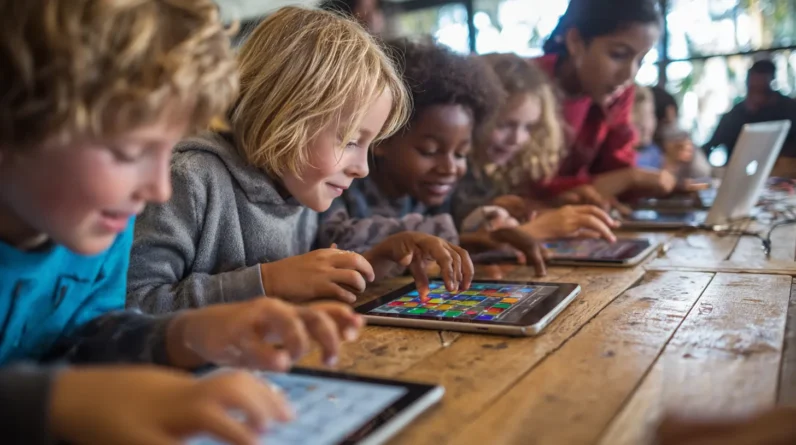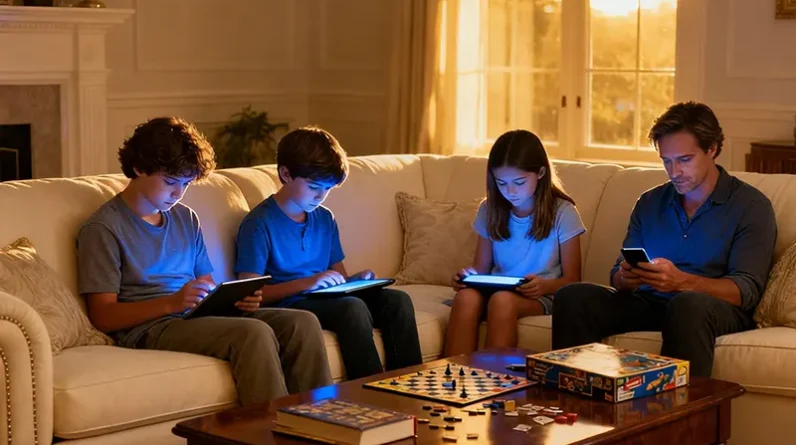
We can transform screen time battles by setting natural boundaries rather than punitive limits. Research shows that involving children in creating collaborative agreements helps them develop self-regulation skills while honoring family values like sleep, physical activity, and connection. When we frame screen limits as protective guidance—similar to how we naturally limit candy—children learn to recognize their own responses to technology. Responding with empathy when resistance arises builds trust and teaches emotional navigation skills that support lifelong healthy technology relationships.
Understanding the Difference Between Punishment and Natural Boundaries
When we establish screen time limits for our children, we’re not implementing punishment—we’re creating natural boundaries that support healthy development. Punishment focuses on consequences after poor choices, while boundaries proactively guide behavior toward ideal outcomes.
Natural boundaries mirror real-world limitations—just as we wouldn’t let children eat unlimited candy, unlimited screen exposure disrupts sleep patterns, attention spans, and social development. Research demonstrates that excessive screen time correlates with increased anxiety, reduced physical activity, and compromised academic performance.
Our parental influence shapes how children perceive these limits. When we frame boundaries as protective rather than restrictive, children develop healthier relationships with technology. This approach also helps them understand their digital footprint’s long-term implications, fostering responsible digital citizenship that extends beyond childhood.
Building Collaborative Screen Time Agreements With Your Children
Rather than imposing screen time rules unilaterally, we can involve our children in creating agreements that they’ll more readily embrace and follow. This collaborative approach transforms screen contracts from restrictive mandates into shared commitments that honor both family values and children’s developmental needs.
When we invite our children into these conversations, we’re teaching essential life skills: negotiation, self-reflection, and personal responsibility. Start by discussing family priorities together—homework, physical activity, sleep, and connection time. Then explore how screens can support rather than compete with these values.
Effective parental guidance involves asking questions like “What feels like enough screen time for you?” and “How can we help you notice when it’s time to shift?” This approach builds internal motivation and self-regulation skills that external rules simply can’t develop.
Teaching Self-Regulation Through Mindful Technology Use
Self-regulation doesn’t emerge overnight—it’s a skill we can nurture by helping our children develop awareness of their internal responses to technology. Digital parenting thrives when we teach mindful browsing rather than imposing rigid restrictions.
We can guide children to recognize their body’s signals and emotional states during screen use:
- Notice physical sensations: “How do your eyes feel after watching? Are your shoulders tense?”
- Identify emotional responses: “Do you feel energized, anxious, or calm after this content?”
- Practice intentional pausing: “Let’s take three deep breaths before switching apps.”
- Reflect on choices: “What drew you to spend extra time on that game?”
This approach transforms screen time from mindless consumption into conscious decision-making, fostering lifelong self-awareness skills.
Responding to Screen Time Resistance With Empathy and Connection
This approach prevents the shame cycle that fuels digital addiction patterns. Instead of battling our children, we’re teaching them to navigate difficult emotions. When parental guilt tempts us to abandon limits, remember that compassionate boundary-setting builds trust. We’re not denying their autonomy; we’re helping them develop the executive function skills they’ll need to self-regulate technology use throughout their lives.
Creating Family Media Plans That Honor Everyone’s Needs
Building those self-regulation skills becomes much easier when we involve our children in creating a family media plan that reflects everyone’s unique needs and developmental stages. This collaborative approach teaches media literacy while fostering digital citizenship from an early age.
When we co-create these agreements, we’re honoring each family member’s perspective:
- Assess individual needs – Consider age-appropriate content, learning styles, and emotional regulation capacity
- Establish shared values – Discuss what healthy technology use looks like for your family
- Set flexible boundaries – Create guidelines that adapt as children demonstrate growing self-awareness
- Schedule regular check-ins – Review what’s working and adjust agreements together
This process transforms screen time from a battleground into a collaborative learning opportunity where children develop critical thinking about their media consumption.
Conclusion
We’ve explored compassionate screen time boundaries, but let’s be honest—we’re still the generation who panic-googled “Is my toddler’s brain melting?” after discovering they watched three YouTube videos. Research shows kids thrive with consistent, empathetic limits rather than device-snatching drama. When we model mindful tech use instead of scrolling while lecturing about screen addiction, we’re teaching genuine self-regulation. Our children’s relationship with technology mirrors our own—imperfect, evolving, and surprisingly human.







